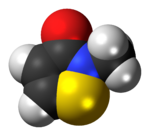Methylisothiazolinone
 |
|
 |
|
| Names | |
|---|---|
|
Preferred IUPAC name
2-Methyl-1,2-thiazol-3(2H)-one
|
|
| Other names
2-Methylisothiazol-3(2H)-one
2-Methyl-4-isothiazolin-3-one |
|
| Identifiers | |
|
2682-20-4 |
|
| 3D model (Jmol) | Interactive image |
| Abbreviations | MIT |
| ChEBI |
CHEBI:53620 |
| ChemSpider |
36393 |
| ECHA InfoCard | 100.018.399 |
| EC Number | 220-239-6 |
| PubChem | 39800 |
| UNII |
229D0E1QFA |
|
|
|
|
| Properties | |
| C4H5NOS | |
| Molar mass | 115.1 g/mol |
| Hazards | |
| S-phrases | (S2) S26 S28 S36/37/39 S45 S60 S61 |
| R/S statement | R23/24/25 R34 R43 R50/53 |
|
Except where otherwise noted, data are given for materials in their standard state (at 25 °C [77 °F], 100 kPa).
|
|
|
|
|
| Infobox references | |
Methylisothiazolinone, MIT, or MI, (sometimes erroneously called methylisothiazoline), is a powerful synthetic biocide and preservative within the group of isothiazolinones, which is used in numerous personal care products and a wide range of industrial applications.
It is a cytotoxin that may affect different types of cells. Its use for a wide range of personal products for humans, such as cosmetics, lotions, moisturizers, sanitary wipes, shampoos, and sunscreens, more than doubled during the first decade of the twenty-first century and has been reported as a contact sensitizing agent by the European Commission’s Scientific Committee on Consumer Safety.
Industrial applications also are quite wide ranging, from preservative and sanitizing uses to antimicrobial agents, energy production, metalworking fluids, mining, paint manufacturing, and paper manufacturing, many of which increase potential exposure to it by humans as well as organisms, both terrestrial and marine. Industrial applications in marine environments are proving to be toxic to marine life, for instance, when the effect of its now almost-universal use in boat hull paint was examined.
Methylisothiazolinone and other isothiazolinone-derived biocides are used for controlling microbial growth in water-containing solutions. Two of the most widely used isothiazolinone biocides are 5-chloro-2-methyl-4-isothiazolin-3-one (chloromethylisothiazolinone or CMIT) and 2-methyl-4-isothiazolin-3-one (methylisothiazolinone or MIT), which are the active ingredients in a 3:1 mixture (CMIT:MIT) sold commercially as Kathon. Kathon is supplied to manufacturers as a concentrated stock solution containing from 10-15% of CMIT/MIT. For applications the recommended use level is from 6 ppm to 75 ppm active isothiazolones. Biocidal applications range from industrial water storage tanks to cooling units, in processes as varied as mining, paper manufacturing, metalworking fluids and energy production.
Kathon also has been used to control slime in the manufacture of paper products that contact food. In addition, this product serves as an antimicrobial agent in latex adhesives and in paper coatings that also contact food.
One isothiazolinone, Sea-Nine 211 (4,5-dichloro-2-n-octyl-4-isothiazolino-3-one, DCOI), has quickly replaced tributyltin as the antifouling agent of choice in ship hull paint. A recent study reported the presence of DCOI in both port water and sediment samples in Osaka, Japan, especially in weakly circulating mooring areas. Of environmental concern, DCOI levels predicted in marinas now are considered a threat to various marine invertebrate species. Isothiazolinones also are extremely toxic to fish.
...
Wikipedia
